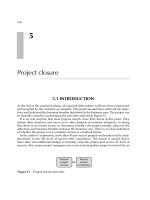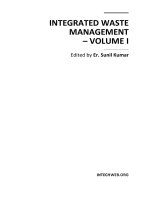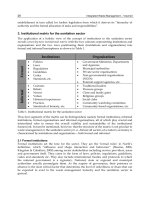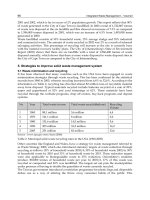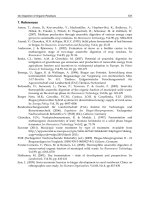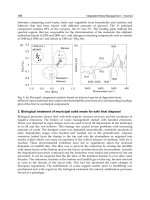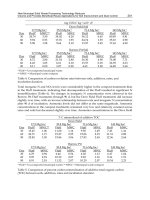Integrated Waste Management Volume I Part 4 pptx
Bạn đang xem bản rút gọn của tài liệu. Xem và tải ngay bản đầy đủ của tài liệu tại đây (2.19 MB, 35 trang )
Integrated Waste Management – Volume I
96
2001 and 2002, which is far in excess of 2% population growth. This report reflects that 90%
of waste generated in the City of Cape Town is landfilled. In 2002 a total of 1,722,807 tonnes
of waste was disposed at the six landfills and this showed an increase of 7.3% as compared
to 1,596,000 tonnes disposed in 2001, which was an increase of 6.5% from 1,493,000 tones
generated in 2000.
Waste landfilled consists of 30% household waste, 15% sewage sludge and 55% industrial
and commercial waste. The amount of waste recycled in 2002 was 2% as a result of informal
salvaging activities. This percentage of recycling will increase as the city is currently busy
with the material recovery facility plans. The City of Johannesburg’s State of Environment
Report (2003) shows that there are six landfills with a total of 1,560,400 tonnes of waste
disposed annually, which shows that there is more waste disposed to waste disposal sites in
the City of Cape Town as compared to the City of Johannesburg.
5. Strategies to improve solid waste management system
5.1 Waste minimisation and recycling
It has been observed that many countries such as the USA have been engaged in waste
minimization strategies through waste recycling. This has been confirmed by the statistical
records from 1960 to 2005, wherein recycling increased from 6,4% to 32,6%. According to the
information on Table 2, recycling has diverted almost 82 million tons of recyclable material
away from disposal. Typical materials recycled include batteries recycled at a rate of 99%,
paper and paperboard at 52% and yard trimmings at 62%. These materials have been
recycled through the curbside programs, drop off centers, buy-back programs and deposit
systems.
No Year Total waste in tons Total waste recyclable(tons) Recycling
(%)rate
1 1960 88,1 million 5,6 million 6,4
2 1970 121.1 million 8 million 6,6
3 1980 151,6 million 14,5 million 9,6
4 1990 205 million 33,2 million 16,2
5 2005 251 million 82 million 32,6
Source : www.epa.gov.msw/facts (2006)
Table 2. Municipal solid waste recycling rates in the USA (1960-2005)
Other countries like England and Wales, have a strategy for waste management referred to
as Waste Strategy 2000, which also introduced statutory targets of waste reduction through
recycling as follows: 20% of household waste 2003/4; 30% of household waste 2005/6; 30%
of household waste by 2010 and 33% of household waste by 2015. These reduction targets
were also applicable to biodegradable waste to 35% reduction. Oxfordshire‘s residents
produce 300,000 tonnes of household waste per year. In 2001/2, 17% of this waste was
recycled or composted and 83% was landfilled. The targets set out puts the municipalities
under pressure of having to double the quantities of waste currently recycled.
The Taiwan government introduced a restriction programme for plastic bags and disposable
dishes use as a way of altering the throw away consumer habits of the public. This
Management of Municipal Solid Wastes: A Case Study in Limpopo Province, South Africa
97
programme was aimed at encouraging the businesses to introduce re-usable shopping bags
and dishes. The target was to reduce the amount of plastic bags by 20,000 tonnes annually,
which had an effect since 31% reduction rate, was achieved. The same applies to disposable
dishes where consumption was 12,000 tons and reduction rate of 28% was achieved.
South Africa developed a national waste management strategy in 1997 which outlines the
different action plans that include waste minimisation and recycling. This action plan
resulted in the formulation of guideline on recycling of solid waste for the municipalities to
use when implementing recycling programmes in their areas
Recycling in South Africa has so far focused mainly on paper, glass, plastics and metals.
Well established companies have been involved in recycling in order to reduce the
utilization of natural raw materials as resources in the production systems. Recycling plays
an important role in the reduction of landfill space. For example, 1 tonne of paper waste
occupies 3 m
3
of landfill space. The following facts represent a brief state of recycling in
South Africa (PACSA, 2002):
In 1999 it was reported that the paper industry recycled 720,000 tonnes per annum
which represents 38% of paper produced and an increase from 29% in 1984. Out of the
3% recycled waste in that year, only 2% was from domestic waste. Almost each and
every type of paper in South Africa has a recycling content. For example, newspaper
contains 25% recycled paper, cardboxes 50%.
Total plastics collected in South Africa were 113,000 tonnes which was 13%. This
quantity had resulted in placing South Africa in the fore front in plastic recycling
industry world-wide.
Glass collection has grown from 54,370 tonnes in 1986 to 104,550 tonnes in 1999. The
total tonnage produced in 1999 was 520,000 tonnes, thus 20% was recycled.
There were 32,130 tonnes of returnable bottles that were collected in 1999 from South
African Brewery (SAB) and Coca Cola Company as bottles that reached the end of life.
The quantities of bottles increased as a result of change-over from 1 litre bottles to 1.25
litre bottles, which resulted in 8,000 tonnes of bottles collected.
Steel beverage cans have a high recovery rate in South Africa as it has grown from 18%
in 1992 to 63% in 1998. These increases have also been affected by the subsidies offered
by “Collect a can” for collection system. Based on assessment made on the rate of
collection for different recyclables, materials without subsidies like glass always had the
lowest recovery rate.
Currently, in South Africa, the statistics presented by Packaging Council of South Africa
(PACSA, 2002) shows that recycling is increasing enormously from time to time with an
increase of above 168 % over a period of 18 years (Table 3).
Material 1984 (tons) 2000 (tons) 2002 (tons) Increase (tons)
Paper and Board 365 000 770 000 922 000 557 000
Plastics 37 000 133 000 150 000 113 000
Metal 34 000 121 000 119 000 85 000
Glass 50 000 102 500 114 000 64 000
Total 486 000 1 126 000 1 305 000 819 000
Table 3. Total recyclable materials collected in South Africa (1984-2002)
Integrated Waste Management – Volume I
98
5.2 Source reduction
Source reduction involves altering the design, manufacture, or use of products and
materials to reduce the amount and toxicity of what gets thrown away. Source reduction can
be a successful method of reducing waste generation. Practices such as glass recycling,
backyard composting, two-sided copying of paper, and transport packaging reduction by
industry have yielded substantial benefits through source reduction. Source reduction has
many environmental benefits. It prevents emissions of many greenhouse gases, reduces
pollutants, saves energy, conserves resources, and reduces the need for new landfills and
incinerators.
More than 55 million tons of municipal solid waste were source reduced in the United States
in 2000, and this comprised 28% containers and packaging materials, 17% non-durable
goods (newspapers, clothing) , 10% durable goods (appliances, furniture, tires), 45% other
MSW (yard trimmings, food scraps) (www.epa.gov.msw/facts, 2006). Most countries have
developed strategies aimed at reducing waste generation by addressing waste from the
source.
Polokwane Declaration on Zero Waste by 2022 was agreed upon at a meeting held in
Polokwane city in 2000 so as to address the problems of waste in the country. This
declaration was based on the urgent need to reduce, re-use and recycle waste in order to
protect the environment and the waste management system which promotes effective waste
reduction. The goal of this declaration was to reduce waste generation and disposal by 50%
and 25% respectively by 2012 and develop a zero waste plan by 2022. The South African
Government developed a National Waste Management Strategy to address waste
management aspects including the zero waste plan as envisaged.
Other initiatives taken by the South African Government is the plastic bag agreement. South
Africa ammended the Environmental Conservation Act 73 of 1989 by developing plastic
regulation in terms of section 24. This regulation came as a result of problems associated
with the collection and disposal of plastic bags which resulted in pollution and degradation.
The problem was mainly affecting low income areas where refuse removal services are
inadequate. The regulation’s main aim is to restrict the production of non-reusable plastic
bags, and unnecessary use of excessive amounts of disposable thin plastic film for
packaging.
6. Materials and methods
6.1 Quantitative and qualitative method
The quantitative and qualitative methods were applied during the study. This incorporated
questionnaires and interviews, field surveys and data presentation.
6.2 Quantitative method
This method was applied through weighing waste generated in all the different waste
generators. It was applied through field surveys that were conducted for data collection
from households and analysed to address the research objectives.
6.3 Qualitative method
Structured questionnaire was used as one of the data collection methods This questionnaire
was used to collect information from the municipality officials through an interview
Management of Municipal Solid Wastes: A Case Study in Limpopo Province, South Africa
99
regarding waste management services and practices for Polokwane city. The questionnaire
was structured for open- ended questions, where the municipality officials provided
answers from questions that were asked, and close-ended questions, where some response
and answers were provided.
6.4 Field survey
On-site waste separation and measurements were done at individual households from the
three income groups at Ivypark, Florapark and Sterpark residential areas, representing low,
middle and high incomes respectively. The three categories were based on the municipality
categories of income which is done according to the size of the residential stand (Table 4). A
10 l plastic bin and 100 kg weighing scale were used to collect and weigh the wastes selected
for sampling from households. Gloves and refuse bags were used for sorting the wastes;
while facemasks and worksuits were used for protection during the sampling and
measurement period.
Income level Size of the residential site
Low 0 - 300 m
2
Medium 300 – 500 m
2
High 500 m
2
+
Source: Polokwane Spatial Development Framework
Table 4. Classification of low, medium and high level incomes based on the size of the
residential space occupied
The formula below was used to determine the number of samples in all the three income
groups:
b
W
g
W W
t
(1)
Where:
Wg
= Waste generated per income group per week,
W
t
= gross weight of bin and waste
W
b
= weight of empty bin
First the weight (W
b
) of empty bin, using the weighing balance, was determined. Thereafter,
the bin was filled with the sorted waste, while shaking the bin constantly to fill the voids.
The difference corresponded to the weight of the waste.
6.5 Data analysis
The data obtained were subjected to statistical analysis in order to establish whether there
was any significant relationship between the quantity of waste obtained and the income
groups. The significant relationship was based on 95% level of confidence. The proportional
allocation of samples in the three income groups was based on the formula used for
stratified sampling which was as follows:
Low income group
Integrated Waste Management – Volume I
100
Nix n
ni
N
(2)
Where: ni = sample size per income group,
Ni =Total population per income group,
N= Total population of the three income groups
n=General sample size of all the three income group
A total of 325 households were sampled out of 2111 households within the three income
groups. The distribution of the sampled household was as follows:
Low income group (Ivypark): 77 households were sampled out of a total of 500
households
Middle income group (Florapark): 194 households were sampled out of a total of 126
Households.
High income group (Sterpark): 54 households were sampled out of a total of 350
households.
To calculate the total waste generated by each income group, the following formula was
used:
W
W
W
b
a
d
(3)
where:
W
a
= Total waste generated day/income group,
W
b
= Total no of households sampled
W
d
= No of days in a week
Similarly, to calculate the amount of waste that was generated per day per household
involves the following formula:
k
h
W
W
W
a
(4)
Where:
W
k
= Total waste generated /day/household,
W
a
= Total waste generated/day/income group and
W
h
= No of households sampled/income group
7. Results and interpretation
7.1 Waste generation
The study focused on the household solid waste generated within the three selected
residential areas of Polokwane city, namely: Low income-Ivypark, Middle income-Florapark
and High income-Sterpark (Table 5). Food waste was the highest across all the income
groups with a percentage waste generation of 34% (Table 5a). The trend of wastes was as
follows: Paper-20% > plastics-18% >glass-11% > cans- 11% >garden waste –6% (Table 5b).
represent waste composition generated per household per day per person from the income
groups. The mean composition of waste generation in the three groups is presented in
Figure 3.
Management of Municipal Solid Wastes: A Case Study in Limpopo Province, South Africa
101
Waste
component
Low -income
group
(kg/week)
Middle
income
group(kg/we
ek)
High-
income
group
(kg/week)
Total
waste
generated
(kg)/week
Average
waste
generated
(kg)/week
Paper
183 658 422 1263 421
Cans
153 437 88 678 226
Glass
261 347 112 719 240
Plastics
181 571 406 1158 386
Food wastes
341 1227 640 2208 736
Garden
waste
194 154 33 381 127
Total waste
generated
per week
1313 3392 1702 6406 2135
Table 5. (a) Total waste composition from the three income groups
Waste
component
Low -
income
group (%)
Middle-
income group
(%)
High-income
group (%)
Average waste
generated/week (%)
Paper
14 19 25 20
Cans
12 13 5 11
Glass
20 10 7 11
Plastics
14 17 24 18
Food wastes
25 36 37 34
Garden
waste
15 5 2 6
Table 5. (b) Percentage of total waste composition generated per week from the three income
groups
Integrated Waste Management – Volume I
102
Waste
com-
ponent
Low -income group
Middle-income
group (kg/week)
High-income
group (kg/week)
Mean
Kg/hou
sehold/
day
Kg/househol
d/day/person
Kg/house
hold/day
Kg/hou
sehold
/day/pe
rson
Kg/house
hold/day
Kg/hou
sehold/
day/per
son
Kg/house
hold/day
Kg/hou
sehold
/day/pe
rson
Paper
0.39 0.05 0.48 0.08 1.11 0.18 0.66 0.11
Cans
0.28 0.04 0.32 0.05 0.23 0.03 0.27 0.04
Glass
0.14 0.02 0.26 0.04 0.29 0.04 0.23 0.03
Plastics
0.33 0.05 0.42 0.07 1.07 0.17 0.60 0.10
Food
wastes
0.63 0.10 0.90 0.15 1.69 0.28 1.07 0.17
Garden
waste
0.36 0.06 0.11 0.01 0.08 0.01 0.18 0.03
Total
waste
gene-
rated
2.1 0.32 2.5 0.4 4.47 0.7 3.01 0.48
Table 5. (c) Total waste composition generated per household per day per person from the
three income groups
6%
11%
11%
18%
20%
34%
Garden waste
Cans
Glass
Plastics
Papers
Food Wastes
Fig. 3. Mean composition of waste generation for the three income groups
Management of Municipal Solid Wastes: A Case Study in Limpopo Province, South Africa
103
7.1.1 Waste generation in the low income group
The waste generated income in the low group was as follows: food waste 25% (341
kg/week) >glass -20% (261 kg/week) > garden waste – 15% (194 kg/week) > paper and
plastic - 14% (181 kg/week plastic and 183 kg/week) > cans 12 % (153 kg/week) (Fig. 4).
12%
14%
14%
15%
20%
25%
CANS
PLASTICS
PAPER
GARDEN WASTE
GLASS
FOOD WASTES
Fig. 4. Composition and percentage of waste generation from low income group.
7.1.2 Waste generation in the middle income group
Similarly in the Middle Income Group, waste was generated as follows (Fig. 5): food waste -
36% (1,226.50 kg/per week) > paper -19% (658 kg/week) > plastics - 17% (570.50 kg/week)
> cans - 13% (436.50 kg/week) > glass - 10% (346.50 kg/week) > garden waste - 5% (153
kg/week).
5%
10%
13%
17%
19%
36%
GARDEN WASTE
GL A S S
CANS
PL A STIC S
PAPER
FOOD WASTES
Fig. 5. Composition and percentage of waste generation from middle income group.
Integrated Waste Management – Volume I
104
7.1.3 Waste generation in high income group
The composition and amount of waste generated was as follows (Fig. 6): food waste - 37%
(640 kg/per week)> paper - 25% (422 kg/week) > plastic - 24% (406 kg/week) > glass - 7%
(112.40 kg/week)> cans - 5 % (88.50 kg/week)> garden waste - 5% (33 kg/week).
2%
5%
7%
25%
24%
37%
GARDEN WASTE
CANS
GLASS
PAPER
PLASTICS
FOOD WASTES
Fig. 6. Composition and percentage of waste generation from high income group.
7.2 Waste management system
Observations of the waste management system was made during sampling and follow up
interviews were conducted with the personnel of the Department of Waste Management in
Polokwane city, focusing on the waste management system, policies, municipality by-laws
and regulations in place for controlling household waste. The response focused on Waste
Management Policy, waste collection and transportation, and allocation of resources for
refuse collection.
7.2.1 Waste management policy
Polokwane city is currently reviewing the refuse (solid waste) and sanitary by-law, the
Administrative Notice No 845 of 1983, in line with the Integrated Waste Management Plan
for the city. This notice addresses illegal dumping and sanitation related problems and
penalties thereof in open places within the residential areas.
The policy has to be in line with the Constitution of South Africa 108 of 1996 and the
Environmental Management Legislation, namely, National Environmental Management Act
(1998), the Local Government Structures Act 117 of 1998 and the Local Government
Municipal System Act 32 of 2000 which outlined the roles, responsibilities and the
operations of all the municipalities. The development of Waste Management Plan is also in
progress in order to align its function with the National Waste Management Strategy (1998)
and Polokwane Declaration of Zero waste (2000).
Management of Municipal Solid Wastes: A Case Study in Limpopo Province, South Africa
105
7.2.2 Solid waste collection and disposal
It was noted that wastes from the households were not sorted. Instead, all the wastes
collected from individual households were mixed in refuse bags. This makes recycling of
wastes from homes not practical, and thereby reducing the quality of recyclable wastes like
paper and cardboard through mixing of waste.
The waste refuse bags from households are collected weekly on a specific day for each
suburb. For example, for Ivypark, collection is on Thursday, Florapark collection on
Wednesday and Sterpark on Tuesday. The amount of waste collected on a weekly basis
from the residential areas and city center amounts to 456 m
3
.
The collection system is quite
effective, thus no refuse bag is left by the road side to litter the city.
There are four cooperatives involved in litter picking in the city with a total number of 47
workers and four ton truck for collection of waste from litter picking group. The
municipality has allocated a total of 13 contractors that collect waste from residential areas
in refuse bags and bins in the business area, 3 loadlaggers that collect solid waste from the
skips in the factories, 7 grab that collect waste in transfer station and illegal dumping areas,
and 3 multilifts for waste bins in the factories.
Waste was being disposed in one permitted waste disposal site, named the Weltevreden
Landfill. The permit was issued in 1998 by the Department of Water Affairs and Forestry in
terms of the Environment Conservations Act of 1973. In this case, Polokwane landfill had a
license for operations which most municipalities in the Limpopo province do not have.
Johansen and Boyer (1999) indicated in their study that South Africa is the only country in
Africa with specific regulations and guidelines in place governing solid waste landfills. The
minimum guidelines requirements for landfill classify land fills in terms of type of waste,
size of waste stream and climatic conditions with focus on leachate generation. Polokwane
landfill has been licensed as a G: M: B site which allows disposal of dry industrial waste, dry
domestic waste, builder’s rubble and garden waste. This classification allows for disposal of
General waste, size is Medium, B- climatic water balance with no leachate management
system required based on site specific factors of rainfall and evaporation rate (DWAF, 1998).
7.2.3 Waste recycling
Currently, there is no recycling programme implemented by the Municipality of Polokwane
City. It has been found that 60% of waste disposed in the landfill consists of recyclable
waste. Although the Municipality does not have a formal waste recycling system, it was
found that the disposal site has informal waste reclaimers that are collecting recyclable
wastes on a daily basis. This has also led to the development of an informal settlement close
to the landfill. Waste reclaimers collect all the waste that is re-usable/recyclable ranging
from bricks, plastics, steel, card boxes and cans (Fig. 7). Interview was conducted with the
waste reclaimers to get data on the amount of recyclable waste collected per day.
Unfortunately they never kept records of the amount collected apart from the price per
Kilogram. For example, plastic- 60
cents/kg, aluminum cans-R 2/kg, cardboxes-R30/kg,
plastic 2l cold drink containers -80
cents/kg, plastic milk containers -50
cents/kg, copper-R
15/kg brass R 4/kg. They were able to quantify the amount of money received at the end of
the month which was approximately R300 per person, depending on the rate of collection
for every individual.
Consultation with the recycling agent that collects waste from the reclaimers indicated that a
total of 2,7120 kg recyclable waste was being collected from the landfill site daily, then sent
to large recycling industries in Gauteng for further processing.
Integrated Waste Management – Volume I
106
Fig. 7. Waste recycling by local waste reclaimers at the landfill site in Polokwane city.
A total of 28,000 m
3
was disposed per month which comes to a total of 336,000 m
3
of waste
disposed per year. The entrance of the landfill had a weigh-bridge (Fig 8), to weigh all the
trucks disposing waste after collection.
Fig. 8. Weighing bridge at the entrance of the Polokwane landfill site.
Management of Municipal Solid Wastes: A Case Study in Limpopo Province, South Africa
107
7.3 Allocation of resources
Resources allocated for refuse collection are as follows: 12 workers and three drivers with
three trucks that are used to collect waste within the residential areas. Each Labourer is
given a set of protective clothing comprising 4 overalls, 2 pairs of boots, 1 pair of rain coat
per year and 1 pair of gloves monthly.
Currently, the Polokwane Municipality makes provisions of about R38,000,000.00 for refuse
removal for the whole municipality. This budget is also supplemented by the monthly
refuse removal services fee paid by residents. The fee is calculated based on the Local
Government Municipal Property Rates Act No 6 of 2004 of South Africa (Table 6). These fees
are revised annually based on the inflation rate and on the size of the size of the
standirrespective of the income levels of different residential areas. The municipality issues
out a utility bill on a monthly basis which incorporates the assessment rates for the property,
sanitation, refuse removal, electricity and water.
Size of residential site Rates payable by residents refuse removal & sanitation
effective from 01/07/2008
0 - 500 m
2
R20.05
500 – 1000m
2
R52.25
1000m
2
+ R93.85
Source: Polokwane Municipality rates policy (2008)
Table 6. Rates for sanitation and refuse removal for Polokwane City
8. Discussion and recommendations
8.1 Waste generation
Globally, the rate of waste generation has increased over the years in different societies with
increase in population and change in lifestyle and technological advancement. Recent
research results reflect a population increase of 8.2 % from 2001 to 2007 in South Africa, and
9.5 % in Polokwane (Statistics S.A-Census 2007). This means that more waste is being
disposed of into the landfill. As the number of land space for the establishment of landfill
sites is becoming limited, other methods of waste management should be sought. This is
where recycling programmes are expected to play a vital role in prolonging the life-span of
landfill sites.
Waste generation in the three income groups was computed to be 0.3-0.7 kg per person per
day, which was distributed as follows: low income group at 0.3 kg per person; middle
income group at 0.4 kg per person and high income group at 0.7 kg per person. This amount
of waste generated was low as compared to the findings of the Baseline Studies (DWAF,
1998). where the average amount of waste generated per person was found to be 0,7 kg per
person in South Africa. Generally, it was observed that the amount of waste generated by
the three income groups depended on the socio-economic level of the group. The High
Integrated Waste Management – Volume I
108
income group was found to generate more waste than the low and middle income groups.
This was attributed to the affordability of goods by this income group.
It is worth noting that the waste generated per person in Polokwane city is lower than that
generated per person in Johannesburg. For example, in Johannesburg, the average waste
generated per income group ranged from 0.4-0.7 kg per person, 0.7-1.1 kg per person and
1.2-2.5 kg per person for low, middle and high income groups respectively (City of
Johannesburg, SOER, 2003). This is rather not surprising since most of the people residing in
Johannesburg earn more than their counterparts in Polokwane and, therefore are expected
to afford more goods which are disposed of after utilization.
8.2 Waste composition
Food waste constitutes the highest percentage of waste generated in all the income groups,
although the percentage varied with the high income group having 37%, middle group-36%
and low income group-25%. The waste composition found in the three income groups
varied markedly. While the waste from the low income group had the highest percentage of
grass waste, and that from the middle and high income groups were composed mainly of
recyclable waste: plastics, glass, paper and cans.
Studies conducted in Nairobi agree with the data in Polokwane city that household waste
comprised high percentage of food waste in all the three income groups sampled. Almost
50 % of waste generated in Nairobi was food waste (Henry et al., 2006), whereas in
Polokwane food waste comprised 34 % of the total waste generated from the income
groups. The studies in Nairobi also stated that 50 % of waste disposed of in landfills in
that country is mostly organic waste which can be reduced by composting before
disposing into landfills.
The results of this study shows that in Polokwane the amount of organic waste generated
amounts to 40% which is low as compared to other studies conducted in Nepal, where
organic wastes was 70% of the total waste generated, and 60 % recyclables for Polokwane
versus the 20.5% (comprised recyclable waste such as cans, plastics and papers generated)
(Viraraghan and Pokkhrel, 2005). According to the studies carried out in Macao in China,
food waste accounted for 15 % of the total waste generated, and 52% was of recyclable waste
(Jin et al., 2005).
8.3 Waste recycling
This study indicated, that about 60 % of wastes generated can be recycled. This included
glass - 11%, plastics -18 %, paper- 20 % and cans-11%. The amount of potentially recyclable
waste in Polokwane city is much high as compared to other cities for example, Nairobi 35 %,
Macao-China 52 %, Singapore 30 % and Kathmandu 20.5 %, (Bai and Suntato, 2002).
Although the Municipality does not have a formal waste recycling system, it was found that
the disposal site had informal waste reclaimers that are collecting recyclable waste on a
daily basis. This has also led to development of an informal settlement close to the landfill.
Waste reclaimers collect all the waste that is re-usable, ranging from bricks, plastics, steel,
card boxes, cans.
No informal recycling programme exists in Polokwane Municipality whereas other
Municipalities such as the City of Johannesburg and the City of Cape Town have initiated
recycling programmes. This is one area that the Municipality must explore in order to
Management of Municipal Solid Wastes: A Case Study in Limpopo Province, South Africa
109
achieve the Polokwane Declaration target on Zero Waste. Trois et al. (2008) investigated the
idea of zero waste in emerging countries using South African experience. In this study, two
communities, adjacent to the Mariannhill Landfill site in Durban were selected as a case
study for comparative analysis of formal and informal settlements. On the basis of the
results of the analysis of the recyclable yields and information provided by the
questionnaire, a waste minimization scheme was proposed for zero waste schemes. This
scheme lays responsibility on households to recycle their waste at source. It makes use of
existing recycling strategies currently applied in other urban areas in South Africa such as
drop off, kerb-side and central sorting. In another study by the same authors (Trois and
Simelane, 2010), studied the possible implementation of separate waste collection and
mechanical biological waste treatment. This model advocates pretreatment of the waste in
passively aerated open windows for 8 weeks before finally taking it to the landfill. The
pretreatment leads to volume reduction due to reduced biodegradable compounds in the
municipal solid waste.
8.4 Waste collection and transportation
Domestic waste is collected from households weekly by the Municipality trucks. The
Municipality has sub-contracted litter picking co-operatives to pick up litter along the streets
in the residential areas and finally dispose at the landfill. Litter collected is not sorted into
recyclables or non-recyclables; is all disposed to the landfill with no sorting, which could be
another area where the Municipality can initiate a recycling programme through the litter
picking cooperatives.
It has been outlined in the baseline studies on waste generation conducted in 1998 and State
of Environmental Report (2003) for City of Johannesburg that over 50% of waste going to the
landfills has the potential to be recovered for recycling or re-use. Based on the information
from the Municipality, a total of 28,000 m
3
of domestic waste is disposed of in Polokwane
landfill. Out of this 60% of waste generated in the households can be recycled, if proper
waste recycling system is put into place.
9. Conclusion
The current study established the following:
The level of income of each household group determines the volume of waste generated
by such a group, thus the higher the level of income for the group, the more waste it
generates.
It was observed that volumes of waste and composition were not the same in each
household group but this depended on the lifestyle, for example, the high income
group had the lowest garden waste since they can afford private garden services that
dispose garden waste after its generated, as compared to the low income group. The
high income group also had the highest percentage of paper waste in a print form,
which is linked to affordability.
The amount of waste from households in Polokwane Municipality that can be recycled
constituted about 60%. This could significantly reduce the amount of waste being
disposed into landfills. The implications of this strategy would lead to the achievement
of the Polokwane Zero waste declaration target of 50% waste reduction by 2010 and
zero waste generation by 2020.
Integrated Waste Management – Volume I
110
10. Recommendations
There is a need to develop an integrated waste management plan for Polokwane city
with a priority on waste recycling to reduce the final amount of waste for disposal.
The Polokwane Municipality should develop an environmental awareness programme
on recycling supported by placement of the recycling containers at strategic points to
collect recyclable waste.
The Municipality should come up with a strategy of supporting household separation
at source.
The programme of cooperatives for litter picking should be extended to include
recycling.
Waste generation is a vital component of waste statistics. The accuracy of these statistics
is important in planning, development and monitoring waste management strategies.
The Municipality should develop a monitoring system for waste classification, quality
and quantity.
11. References
Alter, H. (1989): The origins of municipal solid waste: The relations between residues
from packaging materials and food. Waste Management and Research, 7, pp 103-
114.
Amponsah, S.K. and Salhi, S. (2004): The investigation of a class of capacitated arc routing
problems: The collection of garbage in developing countries. Waste Management,
Vol. 24, pp. 711-721.
Badran, M.F. and Haggar, S.M. (2006): Optimisation of municipal solid waste
management in Port Said, Egypt. Waste Management, Vol. 26, pp. 534-545.
Bai, R. and Suntato, M. (2001): The practice and challenges of solid waste management in
Singapore. Waste Management, Vol. 22, pp. 557-567.
City of Cape Town (2003): City of Cape Town State of Environment Report Year 5 (2002) :
Cape Town, South Africa. pp 151-164.
City of Johannesburg (2003): City of Johannesburg State of Environmental Report 2003 :
Ekurhuleni Metropolitan Municipality, Johannesburg, South Africa,
pp 66-76
DEAT: Department of Environmental Affairs and Tourism (1999): National Waste
Management Strategy Action Plans (NWMSAP), Version C, Pretoria, South
Africa,pp 1-26.
DEAT: Department of Environmental Affairs and Tourism (2000): White Paper on
Integrated Pollution and Waste Management in South Africa. Pretoria, South
Africa, pp 10-14.
DEAT: Department of Environmental Affairs and Tourism (2001): National Waste
Management Strategy (NWMS), Version D, Pretoria, South Africa, pp1-158.
DWAF: Department of Water Affairs and Forestry (1998): Minimum requirements for
waste disposal by landfill,Second edition,South Africa, pp 3-11.
Management of Municipal Solid Wastes: A Case Study in Limpopo Province, South Africa
111
Gidarakos E. Havas G. Ntzamilis P. (2006): Municipal solid waste composition
determination supporting the integrated solid waste management system in the
island of Crete. Waste Management, Vol. 26, pp. 668-679.
Henry, R.K., Yongsheng Z. and Jun, D. (2006): Municipal Solid Waste Management
Challenges in Developing Countries-Kenyan Case Study, Waste Management,
Vol. 26, pp. 92-100.
Hopper J.R. Yaws, C.L. Ho, T.C. Vickhailak, M. (1993): Waste minimization by process
modification. Waste Management, Vol. 13, pp. 3-6.
Hui, Y., Li’ao, W., Fenwei, S. and Gang, H. (2005): Urban Solid Waste Management in
Chongqing: Challenges and Opportunities, Waste Management, Vol. 26, pp.
1052-1062.
Jin, J. Wang, Z. and Ran, S. (2006): Solid Waste Management in Macao: Practices and
Challenges, Waste Management, Vol. 26, pp.1045-1051.
Koushki, P.A. Al-Duaij, U. and Ghimlas, W. (2004): Collection and Transportation cost of
household solid waste in Kuwait. Waste Management, Vol. 24,
pp. 957-964.
Kulcar, T. (1996): Optimising Solid Waste Collection in Brussels, European Journ.
Operational Res, Vol. 90, pp. 71-77.
Mato, R.A.M and Kaseva, M.E. (1999): Critical review of industrial and medical waste
practices in Dar Salaam City. Resources, Conservation and Recycling, Vol.25, pp.
271-287.
PACSA: Packaging Council of South Africa Report (2002): Recycling in the packaging and
related Industries in South Africa, South Africa,pp1-6.
Priestly, J.J. (1968): Civilization, Water and Wastes, Chemistry and Industry,
March 23.
Read, A.D. (1999): Making waste work: Making UK National Solid Waste Strategy Work
at the local scale. Resources, Conservation and Recycling, Vol. 26, pp.259-285.
Slack, R.J. Gronow J.R. and Voulvoulis, N. (2005): Household hazardous waste in
municipal landfills: contaminants in leachate. The science of Total Environment,
Vol. 337, pp. 119-137.
Salhofer, S., Wassermann G. and Binner E. (2007): Strategic Environmental Assessment as
an approach to assess waste management systems. Experiences from an Austrian
case study. Environmental Modelling and Software, Vol. 22, pp. 610-618.
Seadon, J.K. (2006): Integrated waste management: Looking beyond the solid waste
horizon. Waste Management, Vol. 26, pp. 1327-1336.
Tinmaz, E. and Demir, I. (2006): Research on Solid Waste Management System: To
improve existing situation in Corlu Town of Turkey, Vol. 26, pp. 307-314.
Truwing, F.W. and Stread, G.B. (2001): Planning, designing and reporting research. Mack
Miller Longman, Cape Town, South Africa, pp. 30-64
United States Environmental Protection Agency (2006): Municipal Solid waste Generation,
Recycling and Disposal in the U.S: Facts and Figures for 2005,Washington DC, pp
1-12.
Integrated Waste Management – Volume I
112
Vidanaarachchi, C.K., Yuen, S.T.S. and Pilapitiya, S. (2006): Municipal solid waste
management in the Southern Province of Sri Lanka : Problems, issues and
challenges
Part 2
Processing of Solid Waste
7
Dry Digestion of Organic Residues
Sigrid Kusch
1
, Winfried Schäfer
2
and Martin Kranert
1
1
University of Stuttgart; ISWA – Institute for Sanitary Engineering,
Water Quality and Solid Waste Management;
Chair for Waste Management and Emissions
2
MTT Agrifood Research Finland; Animal Production Research, Vihti
1
Germany
2
Finland
1. Introduction
Sustainable development closely links to the context of energy. Replacing fossil fuels with
sustainably produced biomass or organic residues will not only be a way to cope with the
depletion of fossil fuel resources but also to reduce the CO
2
emissions into the atmosphere
and therefore minimise the risk of global warming. A large variety of methods of biomass
energy conversion are available today. Some technologies produce secondary fuel such as
methanol or biomass oil which then can be utilized for various purposes. Especially for
electricity generation efficient processes might be direct combustion, thermal gasification or
the production of biogas.
Anaerobic digestion (AD) with biogas production, including utilisation of the organic
fraction of waste materials and of residues, is a particularly promising choice and
experiences increasing interest worldwide. AD does not only supply a clean and versatile
energy carrier, thus displacing other energy sources such as fossil energy, but is well suited
to contribute towards appropriate waste management schemes in urban areas and in
agriculture. Biogas production has high potential worldwide, and it is in particular
digestion of solid materials which is of increasing interest. As a result, it is to be expected
that so-called dry digestion systems, operated with an elevated content of total solids (TS) in
the reactor, will experience more widespread implementation.
Agricultural residues in general are left on field or are brought back to field in order to
supply fertilizers and to improve soil quality. Anaerobic digestion offers the possibility to
produce renewable energy, and at the same time generates a digestate with an improved
fertilizer value.
Currently the most common strategy for management of municipal solid waste (MSW)
worldwide is still landfill. As a result of higher environmental awareness, and often based
on favourable legislative backgrounds, more and more emphasis is given to recycling and
recovery, and in particular to efficient use of organic materials. Composting and anaerobic
digestion are state-of-the-art for treating organic substrates.
Germany today is leading in the area of biogas production. Around 6,000 AD plants are in
operation, and the number is further increasing. Most plants are in the agricultural sector,
but currently at least 100 plants are run solely on the organic fraction of MSW, a direct result
Integrated Waste Management – Volume I
116
of introduction of source-segregation schemes for household waste. Due to favourable
frameworks the number of AD plants in the municipal field will significantly rise in the
coming years (along with more agricultural plants to be build).
2. Anaerobic digestion: basics
Different types of biomass can be used for biogas production, including organic waste from
gastronomy/food waste, the organic fraction of MSW, organic waste from
industry/commercial waste, sewage sludge, excreta, agricultural residues, and for energy
generation purposes grown energy crops. This book chapter focuses on biogas production
with solid waste materials. The main principles are common in digestion of all materials,
though solid substrates require adaptation of the processes. Separate collection of organic
fractions and diversion from landfill is among the main success criteria.
2.1 Principles and products of the AD process
Biogas is produced in the absence of oxygen (anaerobic digestion) through biological
activity of different microorganisms if the environment is friendly for the microbes (water
content, temperature, nutrients). The substrate must provide all components necessary for
the metabolic processes (C, N, O, H, S, P, K, Ca, Mg), including micronutrients such as
nickel, iron, zinc, manganese, copper, molybdenum, selenium, wolfram. Material should not
have inhibiting substances (e.g. disinfectants, antibiotics, heavy metals). Inhibitory or toxic
effects are in general related to concentration and process conditions. As metabolic
(intermediate) products can also have inhibitory effects (NH
3
, H
2
S, volatile fatty acids, H
2
),
process conditions need to be controlled.
Anaerobic digestion with biogas production is the result of an anaerobic reaction chain with
several steps. Each of the steps hydrolysis, acidification, acetogenesis, methanogenesis
involves specific groups of microorganisms with individual requirements. Efficient biogas
production necessitates that process conditions are favourable (or at least tolerable) for each
of the groups. Microbiology, together with different characteristics of manifold potential
substrates, is one explanation for the large variety of technical solutions to be found in full-
scale applications.
During anaerobic digestion a large part of the energy contained in the biomass is
transformed into methane, an energy carrier which then can be used for example to produce
electricity. Anaerobic digestion of glucose for example leads to biogas which contains 85 %
of the energy content of glucose (2868 kJ/mol contained in glucose after having been formed
in the photosynthesis pathway), see Fig. 1.
Biogas has a wide variety of possible applications, the most common ones are:
Direct use for cooking and lighting (small-scale AD plants at household level)
Utilisation for heat generation
Generation of electricity (several engine types can be fuelled with biogas; electricity
generation is often accompanied by heat generation in combined heat and power
plants/ CHP)
Fuel for cars/vehicles
Feeding into the natural gas grid (after upgrading to natural gas quality; now one
standard in industrialized countries when produced at large scale; different upgrading
technologies exist)
Dry Digestion of Organic Residues
117
Compared to other renewable energies, it is one advantage of the energy carrier biogas that
it can be stored to be used according to fluctuating demands or to availability of alternative
energies. Biogas can be a particularly advantageous choice e.g. in hybrid power systems for
electricity supply in remote areas or islands (Borges Neto at al., 2010). It is not necessary to
make use of biogas directly at the production site. Local biogas grids can be an intelligent
solution to provide biogas to where it can be used at highest efficiency (Panic et al., 2011).
Fig. 1. Energy balance of aerobic and anaerobic degradation of glucose (based on Kranert,
1989)
During digestion, the amount of organic material is reduced in the substrate whereas
nutrients like nitrogen are conserved in the biomass. AD residue therefore is an efficient
fertilizer. Especially with regard to nitrogen biogas residues have excellent nutritional
properties as digestion encourages transformation into bioavailable ammonia. The extent of
nutrient uptake by plants depends on the time of application and there is always the
possibility that nutrients will be leached from the soil when plants are unable to take them
up. While in the organic form nitrogen must be first mineralised, AD converts much of the
organic N into ammonia, yielding a digestate with 60-80% of the total nitrogen content in
the form of ammonia (Banks et al., 2007). This makes it highly predictable, minimises
leaching losses and is in line with the development of good agricultural practices. Ammonia
can be converted to nitrate for plant uptake, while some plants may use ammonia directly.
The improved fertilizer value of AD digestate is to be considered as economic advantage of
the AD unit. Other fertilizers are displaced and higher biomass yields are possible, as has
been reported for napa cabbage, cauliflower (Jian, 2009). Digestate which is not fit for
landspreading (e.g. due to contamination with heavy metals) must be disposed of.
2.2 AD plant types
Many different AD plant types have been developed and are to be found in full-scale for
various applications and in different regions. The following overview is restricted on types
typically implemented for digestion of solid waste materials, agricultural substrates and
household wastes. Table 1 provides an overview on different technology concepts.
Integrated Waste Management – Volume I
118
Operation of
mode: batch,
fed-batch or
continuous
In batch systems the whole substrate is filled at once into the reactor and is
digested over a pre-defined period. When digestion is complete material is
removed and the process is started with a fresh load. In batch systems
digestion and methane production start anew with each filling of the
reactor and biogas supply therefore is not continuous. For commercial
operation it is in general necessary to have several reactors run off-set
(alternative loading and unloading), at least three reactors should be
operated.
In fed-batch mode material is added to the digester by and by until the space
is used up. Then all material is removed and the emptied digester provides
new reactor volume.
In a continuous system (or more precise semi-continuous) substrate is
regularly fed into the reactor, and at the same time effluent is unloaded.
Biogas production is continuous. Such a system in most cases is judged to
be better suited for large-scale operations (Suryawanshi et al., 2010), drastic
changes of input composition should be avoided.
Transport of
material,
homogeni-
sation in
reactor
The most common types of AD plants are based on the concept
continuously stirred tank reactor (CSTR). Plants are equipped with facilities
for stirring the digester content (continuously, or in most cases semi-
continuously), resulting in homogenization of reactor content but also in
differing retention times for different particles, with part of the material
leaving the reactor after very short digestion.
Plug flow digesters are long narrow reactors (typically 5 times as long as the
width) with inlet and outlet at opposite ends. Feeding is carried out semi-
continuously and typically with a thick substrate (~15% TS). In general
there is no internal stirring device, material advances whenever new
substrate is added and in theory the reactor content does not mix
longitudinally on its way towards the outlet (but actually material does not
remain as a plug and portions advance faster than others – but minimum
retention time is assured far better than in CSTR concepts, thus allowing
for better hygienisation).
Total solids
content (TS)
So-called wet digestion plants are most common in agriculture, they are
operated at TS < 12%. When digesting higher amounts of solid materials,
water content needs to be adjusted (addition of liquid substrates, water or
recirculation of digester effluent).
For digestion of organic materials available mainly in solid form,
implementation of technical processes designed for higher TS contents was
a logical step (e.g. municipal bio waste). So-called dry digestion plants are
typically operated at TS > 20%, water content often is not adjusted to a
specific value but is a result of the digesting substrates.
It needs to be mentioned that no final definition based on TS content exists;
in literature other TS limits can be found. Occasionally a third type is
introduced in order to characterise processes operated between 12 to 20%
TS: semi-dry digestion.
Digestion
temperature
Most AD plants are operated in the mesophilic range, optimally around 30-
38 °C. Especially in tropical countries AD plants are operated without
Dry Digestion of Organic Residues
119
temperature control with digestion at ambient temperatures (~20-45 °C).
Mesophilic processes are more stable than thermophilic, the greater
number of mesophile microorganisms makes the process more tolerant to
changes in environmental conditions.
Besides mesophilic AD, thermophilic digestion is a conventional operational
temperature, optimally around 48-57 °C. The increased temperature results
not only in better hygienisation, but in faster reaction rates, and
consequently faster biogas production (shorter retention times, higher
degradation rates). However, the process is less stable and requires higher
energy input for reactor heating.
AD plants operated at psychrophilic temperature (<20 °C) are less common,
they are restricted to low-tech applications. Degradation of organic material
and biogas production are very slow, resulting in long retention times.
One-, or two-
stage (multi-
stage)
systems
In two-stage systems (or multi-stage systems, which however are very rare)
process conditions can be optimized for the different groups of
microorganisms in order to improve overall efficiency. While during the
first phase conditions can be optimized in order to achieve a rapid
liquefaction, the second phase converts soluble matter into biogas.
Compared to single-stage systems the process is more rapid and more
stable, but investment and maintenance costs are considerably higher.
By far the most AD plants are one-stage processes, with one single reactor for
the digestion process (in general followed by a storage tank).
Table 1. Types of digesters
2.3 Digestion at elevated TS contents
In agriculture, continuously operated reactors processing materials with high water contents
are most common. This is to be explained by the fact that slurry was the predominant
substrate for agricultural biogas plants throughout many decades. However, the use of solid
substrates such as yard manure and especially energy crops is becoming more attractive
(Amon et al., 2007; Weiland, 2006). In full scale, digestion of solid biomass is limited in
conventional slurry-plants, due to technical restrictions in particular related to mixing and
feeding devices, and technologies appropriate for operation with elevated content of total
solids (TS) are imperative.
In general, the term ‘dry fermentation’ describes digestion with higher TS content. Since lack
of moisture limits bacteriological activity in all anaerobic systems, no digestion can actually
be ‘dry’. Therefore, the terms ‘solid-state’ digestion (Martin, 1999; Martin et al., 2003) or
‘solid-phase’ digestion (Anand et al., 1991; Chanakya et al., 1997; Kusch et al., 2008) are used
as equivalents to ‘dry digestion’. Similarly, the term ‘liquid-phase digestion’ is used as
equivalent to ‘wet digestion’ for processes operated with low TS content.
Dry digestion is still uncommon in agriculture, but to treat municipal solid waste so-called
dry digestion processes with > 20% TS are implemented to at least a similar extent than wet
digestion processes (Bolzonella et al., 2003; Forster-Carneiro et al., 2008), in general one-
stage processes are favoured (Forster-Carneiro et al., 2008). As MSW is a solid material,
development of technological concepts adapted to high TS contents was a logical step.
While MSW is mainly processed continuously, batch processing of solid material prevails in
agricultural dry digestion systems.
Integrated Waste Management – Volume I
120
Both, single-stage (Kusch et al., 2008; Svensson et al., 2006) and two-stage approaches
(Andersson & Björnsson, 2002; Linke et al., 2006; Parawira et al., 2002) are the subject of
research for both, batch and continuous processing. Section 3 of this Chapter describes in
detail a full-scale application and experimental results of one-stage batch dry digestion, and
Section 4 focuses on two-stage continuous processing.
Dry digestion reduces the risk that process problems will occur due to fibrous materials
floating on top of the liquid, a phenomenon often observed in wet digestion of
lignocellulosic substrates such as straw or straw-containing dung, e.g. from horses (Kalia &
Singh, 1998). Some further advantages associated with dry digestion systems are as follows
(Hoffmann, 2001; Köttner, 2002): lower reactor volume, less process energy, lower transport
capacity, less water consumption.
Monitoring results of 61 full-scale AD plants revealed that in particular continuously
operated dry digestion plants are comparable to wet digestion in terms of general efficiency,
methane productivity (methane generation per net reactor volume and day) and methane
yield (FNR, 2009). It was however pointed out that demands on technical equipment
(stirring devices, pumps) are much higher, due to the elevated viscosity of the digester
content. In addition, there is a higher risk for shortage of micronutrients, and as a result
addition of micronutrients is common. Discontinuous dry digestion in box type digesters
was found to have a higher risk for lower gas yields and for increased odour emissions due
to handling of material outside the digestion boxes (see Chapter 3), but the monitoring
project confirmed that plants are robust and failure rarely occurs.
2.4 Degradability of solid residues
Lignocelluloses comprise a large fraction of solid biomass such as MSW, crop residues,
animal manures, woodlot arisings, forest residues or dedicated energy crops (Sims, 2003).
Global crop residues alone were estimated at about 4 billion Mg for all crops and 3 billion
Mg per annum for lignocellulosic residues of cereals (Lal, 2009). Biogas production from
lignocellulosic biomass is a slow (without pre-treatment having been applied to the
substrate prior to digestion) but steady process. Methane originates mostly from
hemicellulose and cellulose, but not from lignin which cannot be degraded by anaerobic
microorganisms. As in other biochemical conversion pathways, in the anaerobic digestion of
this substrate type, enzymes must first break the lignin barrier in order to gain access to the
degradable components. In order to make these biomasses better available to anaerobic
degradation, various physical or chemical pre-treatment technologies are known, including
thermochemical or ultrasonic pre-treatment, use of different additives or steam pressure
disruption (Liu et al., 2002; Petersson et al., 2007; Yadvika et al., 2004). Though potentially
applicable on larger scale, for lignocellulosic materials contained within solid manure
sophisticated expensive pre-treatment procedures seem inappropriate for utilisation on
single farms. Two-stage digestion with hydrolysis is feasible (see Chapter 4.2).
The actual methane yield depends on the total methane potential, the digestion time and
degradation kinetics (influenced by substrate characteristics and process conditions). The
total methane potential G
pot
= G(t → ∞) can be determined by optimized batch testing,
which should include extrapolation of the experimental findings (Kusch et al., 2008; 2011).
The exploitation degree q
t
= G
t
/G
pot
indicates the proportion of G
pot
released at a specific
point in time (t). Table 2 lists selected experimental results.

